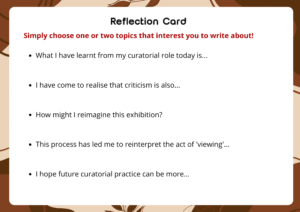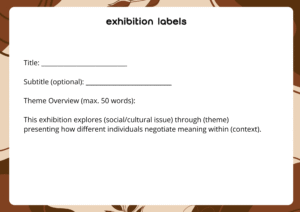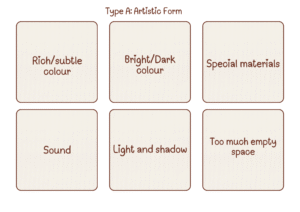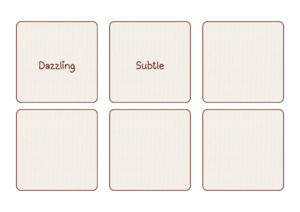Curatopia: A Critical Curation Roleplay Toolkit

Summary
Participants will experience the construction of curatorial frameworks by engaging in exhibition conceptualisation and critical practice through assuming diverse roles within the curatorial process. Utilising this toolkit, participants are encouraged to gain an initial experience of critical dialogue within contemporary art curation.
Ready to step into the shoes of a curator, artist, audience, or critic?
Ready to dive straight into a mini simulated exhibition?
No prior expertise required
Simply immerse yourself in the role
simulate the exhibition
and relish the debate!
🦋
Over these 20 minutes, you’ll engage in exhibition conceptualisation and critical practice by embodying roles within the curatorial process.
Experience the process of constructing curatorial frameworks, artistic judgements, and critical discourse.
❗PLEASE NOTE❗
Role-playing simulations are not merely binary oppositions
Feel free to express
your preferences
and
your confusion
Let this game be grounded in discussion rather than argument!
【The card materials and recommended list included in this toolkit can be found in the appendix at the end.】
LET‘S START!
👇
Number of participants
Recommended group size:
【2 players per group】 or 【4–8 players per group】
Each participant will draw a role:
【4–8 players per group】 Curator / Artist / Critic / Audience
【2 players per group】 Hosting party / Visiting party
Toolkit Material
🎴Identity Card🎴
Including task and authority settings
🖊Curation and Artwork Cards🖊
The exhibition materials within the card kit may be used directly. Alternatively, curators may freely select items from our open museum platform. Should printing prove inconvenient, we support the distribution of digital images via social media groups.
⭐Keyword Cards⭐
(Groups A, B, C, D)
🌈Exhibition Label/Review Card🌈
🎨Feedback Card🎨
(for peer assessment)
📱Stopwatch⌚
(a mobile phone will suffice)
Procedure (4-8 Player Version)
Total duration: approximately 20 minutes
The structure is Drawing cards → Simulated exhibition → Exhibition review → Feedback
STEP 1: Get Cards Randomly (4 minutes)
1. Each participant take one identity card (Curator / Critic / Artist / Audience)
Curator
1 character card [role ideally voluntary. Requires deciding on exhibition type (select one exhibition + x sets of artworks)] + exhibition label card
Artist
1 role card + several artwork cards (when multiple artists are present, each player drawn as an artist receives an equal number of artwork cards) + exhibition label card
Other roles
1 role card + review card (critical comment card)
Public cards
Exhibition cards, artwork cards, keyword cards
↓
Curators select exhibitions and artworks card
(recommended exhibitions and works may be used directly)
↓
Select keyword cards
The Curatorial team(Curators and artists )may additionally choose from Type D; The Visitors (critics and audiences) may additionally choose from Type C. Types A and B are public keyword cards.
↓
Please note:
Unselected keyword cards may still be chosen and utilised during subsequent exhibition processes.
STEP 2: Simulated Exhibition (8–10 minutes)
Participants shall commence the simulated exhibition after thoroughly reviewing the task cards.
All players must fully immerse themselves in their assigned roles—the game begins!
↓
The Curatorial Team shall commence their presentation: the curator and artist introduce the exhibition and works.
The Visitors shall initiate discussion: critics and audience pose questions and raise objections.
Both sides shall engage in debate, with the curatorial team responding to and defending against the viewing audience’s statements.
↓
Please note:
Curators must respond promptly to ‘challenges’, employing either the keyword ‘forced interpretation”‘or a hybrid approach combining ‘technical jargon + gibberish’… In short, since none of us are experts, it’s simply a matter of who sounds more plausible!
STEP 3: Output exhibition labels or short reviews (3-5 minutes)
The Curatorial Team: Artists + curators to draft exhibition labels/curatorial texts (within 50 words)
The Visitors: Audience and critics to compose any number of reviews (within 50 words)
All outputs to be completed using template cards, which may be filled in by hand or printed.
STEP 4Presentation and Reflection (3 min)
A miniature ‘exhibition’ displaying all cards on the table
Curator publicly shares exhibition details
Participants shed their roles and engage in reflection using feedback cards
DONE
Procedure (Two-Player Version)
The process remains identical
with the distinction being that one party assumes the role of the curator and artist(The Curatorial Team)
while the other acts as the critic and audience (The visitor).
Toolkit Appendix
👉Brief Description
This Toolkit constitutes a critical role-playing game which designed to explore power negotiations, cultural contexts, and discursive structures within exhibition curation and art criticism by simulating the multiple identities of ‘curator-critic-artist-audience’ within the contemporary art field.
Participants will conceive, justify, simulate presentations, and engage in reflective feedback around real or fictional contemporary artworks. The process encourages role-rotation, collective negotiation, and critical expression to deepen understanding of curating as a cultural production apparatus.
👉Learning Outcomes
Upon completion of this programme, learners are expected to be able to:
Identify key roles within the curatorial process and their cultural functions (such as artists, curators, critics, audiences, institutions)
Critically analyse contemporary artworks
Practise debate and negotiation within ‘contested cultural fields’ through role-play and group discussions;
Design and articulate a small-scale exhibition or critical text demonstrating an understanding of curatorial structures;
Reflect upon and write about curatorial activities.
card content
You may choose to print or use the electronic version.
Exhibition and Artwork Cards
Exhibition and Artwork Cards



Identity Card
Keyword Preview(part)
📕Recommendations for Open Access Museums and Platforms
-
-
- SMK – Statens Museum for Kunst
-
Website: https://www.smk.dk/en/
License:
-
-
-
- Images on this website not protected by copyright or not marked “© Artist/VISDA” are licensed under CC BY-SA 4.0 by default.
- Public domain works are released under Public Domain / CC0.
- Public domain works of 19th–20th century Danish art, photographs, and exhibition installation images (unless otherwise copyrighted).
-
-
Note: SMK explicitly permits use for teaching and derivative works. Attribution is required when using:
Image: Statens Museum for Kunst (SMK), CC BY-SA 4.0 / CC0.
-
-
- The Metropolitan Museum of Art
-
Website: https://www.metmuseum.org/art/collection
License:
-
-
-
- Modern and Contemporary Art in The Met Open Access Collection.
- Recommended search keywords: Modern Art, 20th Century, Photography, Installation View (CC0).
-
-
Note: Fully available for use in OER, publishing, and re-creation without requiring permission.
Image: The Metropolitan Museum of Art – Open Access (CC0).
-
-
- Tate Gallery
-
Website: https://www.tate.org.uk/art
License:
-
-
- MoMA – The Museum of Modern Art
-
Website: https://www.moma.org/collection/
License:
-
-
-
-
MoMA does not adopt CC licensing across its entire collection, but images marked “© Estate / Licensed by MoMA” within its “Digital Collection” are subject to restrictions.
- Certain early photographs and public domain works are labelled Public Domain / No known copyright.
Suitable exhibitions/works for selection:Modern artworks from the early to mid-20th century (e.g., public domain works by Paul Klee, Brâncuși, Picasso).Select “Public Domain / Open Image Permitted” in the search filters.Note:Public domain works may be freely used for teaching and OER;Contemporary artwork images must remain confined to classroom use.Usage and attribution guidelines (recommended standard format)Image: The Museum of Modern Art (MoMA), Public Domain / Open Image Permitted.In all teaching materials or OER resources, please consistently use the following attribution formatImage credit example:Artist Name, Title of Work, Year. Museum Name – City. Licensed under [CC BY-SA 4.0 / CC0 /Public Domain]. Source: [Museum URL].
-
-
-






